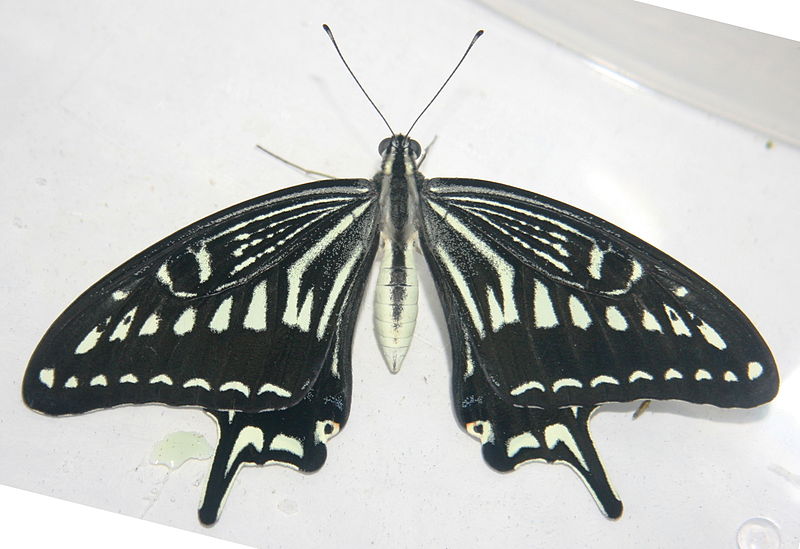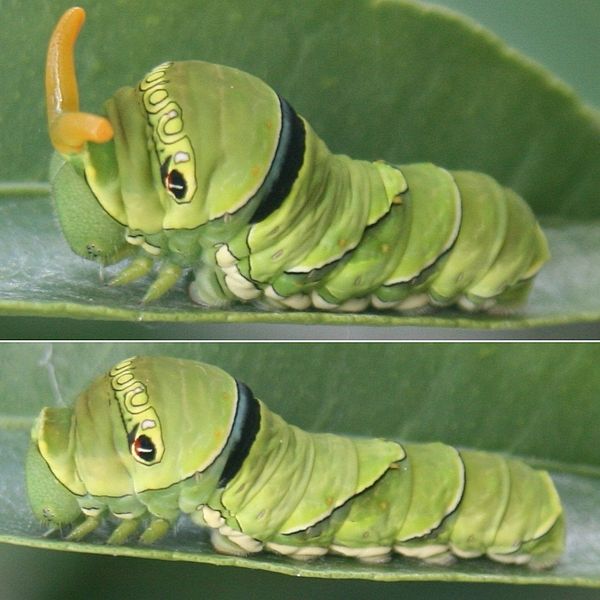Form and Function
The
Papilio
xuthus is a medium-sized butterfly, around four and a half
inches in diameter on average. It has cream, white, and yellow
forms in both sexes, and often has two black postdiscal spots on
its hind wing. Often, small patches of a darker yellow can be
seen near the end of the hind wings (Miller and Miller 2004).
The mature caterpillar is light
green
in color, with small white patches on its inferior surface. In
some cases, there is a black band running across the area that
separates the head segment from the body (Miller and Miller
2004).
All butterflies are endopterygotes, which means that their
body structure completely changes its morphology at least once
during their lifetime (Smart 1985). The butterfly life cycle is
a continuous circle. Much like the age-old question, “which came
first, the chicken or the egg?”, it is debatable whether the
butterfly cycle begins with the egg, the caterpillar, or the
adult butterfly (Schappert 2000). However, the beginning is
often told as the adult female butterfly laying a fertilized
egg. The egg develops into a caterpillar and the caterpillar
matures into a
 butterfly (Schappert 2000).
butterfly (Schappert 2000).
Butterflies encounter many obstacles to survival, including
avoiding predation. Organisms of all kinds have evolved
significantly by natural selection and developed interesting
mechanisms to aid their survival (Kunte 2009). In the genus
Papilio, the distribution of form and function of mimicry
is incredibly complex. In some cases, closely genetically
related species have very different styles of mimicry (Kunte
2009). The P. xuthus has evolved two unique mimicking
traits that aid its survival. First, as young caterpillars
emerge from their eggs, they appear small and black and white in
color. The young caterpillar resembles bird feces that have
fallen onto a leaf (Marshall 2006). This form of Batesian
mimicry is also utilized by other small insects such as beetles
and spiders (Preston-Mafham et al. 1999). The organism
mimics a model species and is successful because the predators
that hunt them mistake them for a dangerous or unappetizing
species and are more likely to leave them alone (Smart 1985).
Because bird droppings are typically relatively small in size, this strategy will only work while the
caterpillar is also small in size (Preston-Mafham et al. 1999).
As it grows, the caterpillar develops another unique form of
mimicry to ward off predators.
relatively small in size, this strategy will only work while the
caterpillar is also small in size (Preston-Mafham et al. 1999).
As it grows, the caterpillar develops another unique form of
mimicry to ward off predators.
The second structure that aids in a P. xuthus’
survival is a forked structure that is ejected from a slit on
the first thoracic segment behind the caterpillar’s head called
an osmeterium. It is bright orange in color and takes on the
appearance of a snake’s forked tongue (Wagner 2005). It is
capable of emitting a strong smelling liquid, terpenee, which is
foul enough to deter predators. It may also scare them by its
sudden appearance and bright color (Marshall 2006).